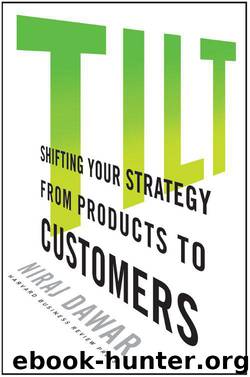Tilt: Shifting Your Strategy from Products to Customers by Niraj Dawar

Author:Niraj Dawar [Dawar, Niraj]
Language: eng
Format: mobi, epub
ISBN: 9781422187173
Publisher: Harvard Business Review Press
Published: 2013-10-14T14:00:00+00:00
Competitive Advantage
The relaying and connecting functions are not easy for competitors to replicate. Once these functions attract a critical mass of users, they become almost insurmountable barriers to entry. If Amazon.com’s competitors wanted to deliver similar information to customers, with similar accuracy and reliability, they would have to replicate the online retailer’s vast footprint—its experience with hundreds of millions of customers, and the experience of millions of those customers with each other. Amazon.com’s competitive advantage resides, literally, with its customers.
As consumers, we all know that Amazon.com’s informational features are designed to get us to buy or buy more. Amazon.com, like any other retailer, wants to maximize the shopping dollars we spend once we are in the store. And by most accounts, this is working rather well—revenues were just over $10 billion in 2006 and have risen fourfold since, during the deepest recession in the United States since the Great Depression. What’s more, customers are happy too: the company has consistently been one of the top two online retailers in ForeSee’s annual retail satisfaction index since 2005. The other frontrunner is Netflix, whose powerful recommendation engine, like Amazon.com’s, remains a long-term competitive advantage.
At the heart of Amazon.com’s recommendation engine is the goal of answering a very simple question for customers: “What’s going on elsewhere?” The relaying of experience is valuable to all users because no single customer knows what is happening everywhere else in the forest. But Amazon.com’s relaying and connecting systems help each customer find the information and products that are relevant to improving his or her experience. This unique added value is as applicable to shoes and baby products, to furniture and electronics, as it is to books. Amazon.com has diversified and acquired other category-focused retailers. While its competitors such as general merchandisers brought to their online operations the mind-set of the offline world: to sell more of the stuff they were already selling, Amazon.com’s approach was building information channels to relay information. And just as in the ICI mining example we saw in chapter 4, this type of competitive advantage has a unique characteristic: the more customers Amazon.com gains, the more informative its reviews become, the more accurate its recommendations are, the more value it adds to customers, and the more business it does at a lower cost. And the less likely it is that competitors can replicate these advantages—its barriers to entry escalate with a larger installed base of customers.
Relaying and connecting are the most valuable when physical or perceptual barriers such as distance, industry boundaries, or knowledge and information fences prevent customers from learning from each other or from accessing other parts of the market. The seller can help bridge the information gap. Where customers find it difficult or costly to learn about new developments or ideas that might be relevant to their own situation, the seller brings efficient access to knowledge and solutions developed elsewhere. Customers find this valuable because it spares them the time, effort, and energy required to reinvent the wheel—especially in areas that are not core to their business or their lives.
Download
Tilt: Shifting Your Strategy from Products to Customers by Niraj Dawar.epub
This site does not store any files on its server. We only index and link to content provided by other sites. Please contact the content providers to delete copyright contents if any and email us, we'll remove relevant links or contents immediately.
Influence: The Psychology of Persuasion by Robert B. Cialdini(4601)
The Miracle Morning by Hal Elrod(4422)
The Hacking of the American Mind by Robert H. Lustig(4085)
Pre-Suasion: A Revolutionary Way to Influence and Persuade by Robert Cialdini(3977)
Unlabel: Selling You Without Selling Out by Marc Ecko(3470)
Ogilvy on Advertising by David Ogilvy(3328)
Hidden Persuasion: 33 psychological influence techniques in advertising by Marc Andrews & Matthijs van Leeuwen & Rick van Baaren(3292)
Purple Cow by Seth Godin(3069)
Who Can You Trust? by Rachel Botsman(3024)
Kick Ass in College: Highest Rated "How to Study in College" Book | 77 Ninja Study Skills Tips and Career Strategies | Motivational for College Students: A Guerrilla Guide to College Success by Fox Gunnar(2998)
This Is Marketing by Seth Godin(2901)
I Live in the Future & Here's How It Works by Nick Bilton(2844)
The Marketing Plan Handbook: Develop Big-Picture Marketing Plans for Pennies on the Dollar by Robert W. Bly(2795)
The Power of Broke by Daymond John(2774)
Building a StoryBrand by Donald Miller(2754)
The 46 Rules of Genius: An Innovator's Guide to Creativity (Voices That Matter) by Marty Neumeier(2678)
Draw to Win: A Crash Course on How to Lead, Sell, and Innovate With Your Visual Mind by Dan Roam(2639)
The Tipping Point by Malcolm Gladwell(2559)
Market Wizards by Jack D. Schwager(2540)
